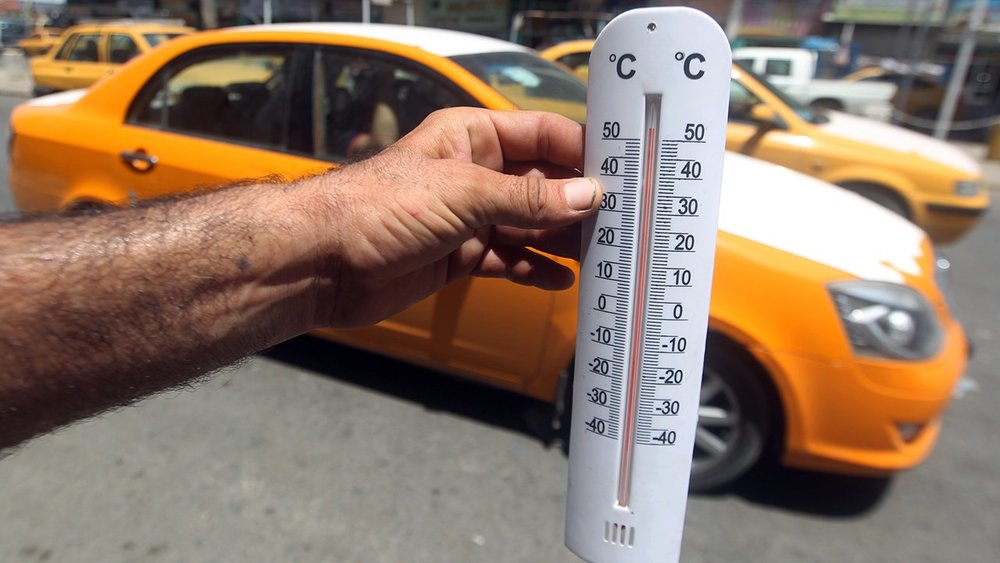Temperature rises across Iran, Ahvaz hits record high

TEHRAN – Iran has experienced an average 1.3 degrees on the Celsius scale temperature rise during the past 10 months (September 23, 2017 to July 22, 2018) compared to the long-term mean with Ahvaz setting the record for the country’s hottest city, the director of the national center for drought and crisis management, affiliated to Meteorological Organization, has said.
Over the 10 past months all Iranian provinces have faced an increase in temperature, Sadeq Ziaeian said, ISNA reported on Saturday.
Over the same period, provinces of West Azarbaijan and Zanjan set the record high for the highest temperature rise, as experienced a temperature rise of 2.2°C and 2°C, respectively, compared to their long-term mean, he added.
He also stated that compared to the long-term mean, Tehran also had 1.5°C increase in temperature over the aforementioned period.
Heat weave hits all Iranian provinces
Referring to the temperature rise of 1.2°C the country has faced over the Iranian calendar month of Tir (June 22-July 22) in comparison to the long-term mean of the same month, Ziaeian explained that last month, Golestan province with 3.7 °C temperature rise and province of Alborz with 3.6°C increase in temperature saw the biggest variations in mean temperatures.
Almost all provinces in the country have also experienced an increase in temperature over the past month, relatively speaking, except province of Yazd with 0.1°C drop in temperature compared to its long-term mean.
Compared to the average temperature reported last year in month of Tir, the capital has faced a temperature rise of 2.2°C this month, he regretted.
Ahvaz hits the record high
He went on to say that Dehram in Fars province and Ahvaz in Khuzestan province with 52.6 and 53 degrees on the Celsius scale, respectively, have experienced the highest temperatures recorded in the country over the same 10-month period.
The temperature over 50°C have been registered about 111 times in different parts of the country, especially in Khuzestan province, he added.
So far, provinces of Ilam, Hormozgan, Bushehr, Fars, and Sistan-Baluchestan have experienced temperatures over 50°C, he highlighted.
“Ahvaz currently holds the record for the country’s hottest temperature of 53°C”, he lamented.
Iran short of rain by 26%
Elsewhere in his remarks Ziaeian noted that in the ten-month period, Iran has received 164.7 millimeters rainfall while the long-term averages are 225 millimeters which indicates a 26.8-perecnt drop in mean precipitation nationwide.
Over the same period last year the country received 210.4 millimeters of rain, which also shows a 21.7 percent decrease compared to the corresponding period last year, he restated.
During the past ten months, Tehran got some 220 millimeters of rain, which compared to the 254- millimeter long-term average precipitation level has seen a 13 percent decrease, he noted, adding that, compared to precipitation level of 295 milliliters reported last year, the city is facing lack of rain by 25 percent.
“The amount of rainfall the country received in the first month of summer, was not significant, as the average precipitation level of the country has been recorded nearly 0.5 millimeter,” he regretted.
He further added that although the rainfall in the summer is negligible, last year in month of Tir, the average rainfall has been reported 2.6 mm, and 3.7 mm in long-term average level.
“Also Tehran did not receive any rainfall during the last month, while its last year precipitation level has been 6.4 mm, and 12.9 mm in comparison to its long-term precipitation level,” Ziaei further stated.
climate change rising temperature
Commenting on the reasons for rising temperatures in Tehran and other provinces of Iran in the first month of summer, Ziaeian highlighted that upward temperature trend across the entire country, is mainly caused by climate change, but synoptic factors, including the subtropical ridge (a significant belt of atmospheric high pressure situated around the latitudes), also affect the issue.
2018 hottest year on record
The past three years were the hottest on record, as the UN World Meteorological Organization (WMO) wrote in its annual report on the global climate. 2016 was the warmest year in records dating back to the 19th century, with 2017 and 2015 tied for second place in a warming trend the WMO blames on man-made emissions of greenhouse gases.
According to data from the National Oceanic and Atmospheric Administration (NOAA), 2018 is on pace to be the fourth hottest year on record.
Temperatures above 32 degrees Celsius extended to the northern reaches of Scandinavia, setting records in Sweden, Finland and Norway for stations above the Arctic Circle.
The United Kingdom, according to the Met Office, has been one of the hottest on record, coming in just 0.1 degrees Celsius behind the average temperature during the hottest summer on record in the UK, which averaged 21 degrees Celsius in 1976.
Meanwhile, countries as distant as Canada and Japan have experienced deadly heatwaves, South Africa is facing its worst drought in more than a century and the U.S. is battling a series of fierce wildfires.
FB/MQ/MG
